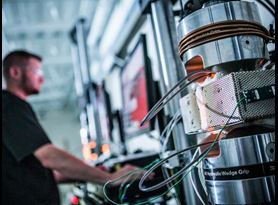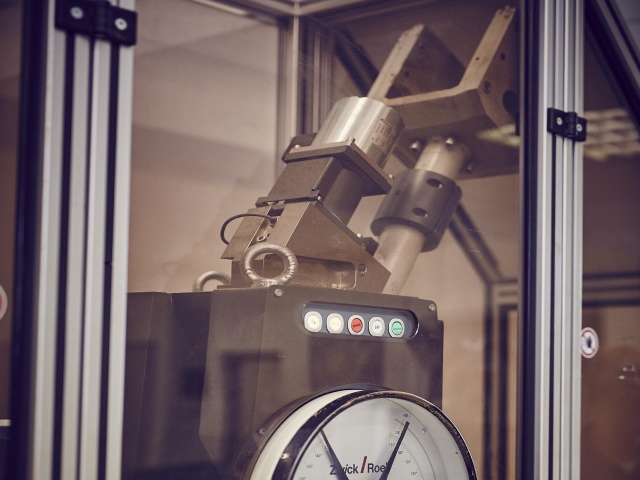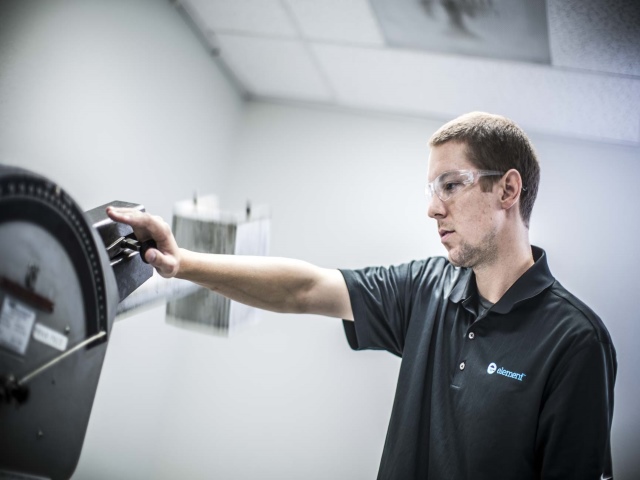Charpy impact testing provides a wealth of material data with a single impact strength test, helping determine if your material is suitable for its intended application, ensuring safety and integrity of components and finished products. Supported by our ISO 17025-accredited testing laboratories, Element’s Charpy impact test services deliver precise test results with competitive turnaround times, helping you align with international standards.
What are charpy impact testing services – and why do you need them?
A Charpy impact test, also known as the Charpy V-notch test, is a destructive method designed to measure the amount of energy that a material can absorb as it fractures. Understanding this helps to predict how the material will react to impact loading and is, therefore, an essential determining factor when assessing if your material is suitable for a particular application.
Using a pendulum hammer arm to strike a notched specimen, the Charpy impact test measures the energy absorbed during fracture, also providing valuable insights into the material's toughness and resistance to brittle fracture. Charpy impact testing is vital to material characterization programs, offering critical information for design and performance evaluation.
Key Benefits of Charpy Impact Testing Services with Element
- Drive R&D and Inform Material Selection: Charpy impact testing with Element provides essential data to understand how different compositions and treatments affect the impact resistance of materials, guiding improvements in design, encouraging the development of improved materials, and enabling you to make informed decisions about material selection.
- Demonstrate Compliance with Industry Standards: Ensure that your products meet safety requirements and perform at the level expected in your specific industry, giving you greater market access and improving customer trust. Element provides the Charpy impact test services in accordance with multiple International standards such as NADCAP, ISO 148, and ASTM E23 for both metallic and polymeric materials.
- Guarantee End-User Safety and Elevate Quality Control: In safety-critical applications like construction or transportation, our testing ensures your materials withstand impact forces, safeguarding end-users. Testing with us integrates seamlessly into your quality control processes, ensuring ongoing assessment to uphold and enhance overall product quality.
- Proactively Manage Risks: Understanding your materials' behaviour under impact allows early identification and mitigation of potential failure risks, enhancing the safety and reliability of your products. Our expert testing identifies and addresses weaknesses, defects, or inconsistencies before market, minimizing the risk of material failure and ensuring high-quality outcomes.
Control costs with Charpy Impact Testing Services
With a comprehensive range of testing options at your disposal, our experts can tailor services to align uniquely with the characteristics of your product. This flexibility allows you to optimize testing protocols, ensuring that the scope of testing precisely meets your project requirements without unnecessary expenses. Moreover, our streamlined testing processes, honed by years of experience, contribute to efficient turnaround times. By offering a broad spectrum of testing capabilities and customization options, we empower you to make informed decisions, mitigate risks, and ultimately enhance cost-effectiveness and project timelines through Charpy testing services.
Supporting you with accurate sampling procedures
Sample preparation for Charpy impact testing is a crucial step involving shaping specimens to specific dimensions and notching them to precise standards to produce accurate results. We understand the issues faced when preparing large or irregularly shaped materials. Our experts employ specialized techniques suited to each material to ensure uniform specimen dimensions and precise notching, guaranteeing the accuracy and reliability of your Charpy impact test results. This ensures you can confidently navigate diverse material types while obtaining accurate and meaningful outcomes.


Justin Riebesel, PE, CWI
Expert metallurgist, Quality Manager and Deputy Export Compliance Officer READ MORE ABOUT JUSTINOur Charpy impact testing capabilities
- Ambient and low-temperature testing
- Cryogenic testing capabilities
- Ductile-brittle transition curves
- Plasticity and deformation
- U-notch, V-notch, and double notched
- Energy absorption characteristics
- Lateral expansion
- Percent shear
- Crystallinity and shear determination
- Use of state-of-the-art Charpy impact machines with a capacity of 450 Joules
- Dynamic Charpy impact - cushioning
- Dynamic Charpy impact - g-force
- Dynamic Charpy impact - impact failure mechanisms
Why Choose Element?
Elements’ commitment extends beyond conducting tests; we actively assist in crafting complex test procedures, ensuring precision and relevance to your unique international requirements. With an experienced team of experts and state-of-the-art laboratories, we can provide you with invaluable support in interpreting test results, offering insights beyond raw data.
Throughout the entire project lifecycle, from initiation to the delivery of a comprehensive report, our extensive testing experience positions us as a reliable partner for projects of any complexity. We recognize the challenges of finding a laboratory that offers a comprehensive suite of Charpy impact testing services. Our experts excel in delivering diverse testing solutions equipped with various instruments, covering both static and dynamic Charpy impact testing. This ensures we can address a broad spectrum of testing needs, offering you a versatile and thorough evaluation of material impact resistance under various conditions.
To speak to an expert about our static and dynamic Charpy impact testing services or to request a quote, contact us today.
Charpy vs. Izod: An Impact Testing Comparison
Both Charpy and Izod impact testing are popular methods of determining impact strength, or toughness, of a material. Learn more from expert Lee Mangham.
READ MOREPerforming the Charpy test to satisfy industry specifications
Charpy Impact strength tests are designed to determine the notch toughness of a material by measuring the amount of energy absorbed as it fractures. DOWNLOADMaterials Testing: Choosing the Right Material for your Application
Explore our case study providing insights into the behavior of materials through determining factors such as hardness, flexibility, strength, and chemical composition.
Read MOREWhat is Destructive Testing?
Destructive testing, also known as mechanical testing, subjects a material to different loads and stresses to evaluate its strength and durability. Read the article to learn about the different methods used for destructive testing.
READ MOREMore from Element

Die Steel Qualification
In addition to hardness and microhardness testing, die steel qualification involves a variety of other Element capabilities including impact testing, heat treatment and metallography.

Mechanical Testing
Element's experts in materials testing labs across the US, UK, Netherlands, Germany, and Spain provide mechanical properties testing such as tensile, fatigue, fracture mechanics, and more.
Sign Up for Free Resources
Visit Element's email subscription center to receive the latest industry news, technical whitepapers, case studies, webinars, and upcoming events.

Element Locations
Learn more about our laboratories - where they are located; the unique capabilities they have and how they can help you solve your technical and commercial challenges.



